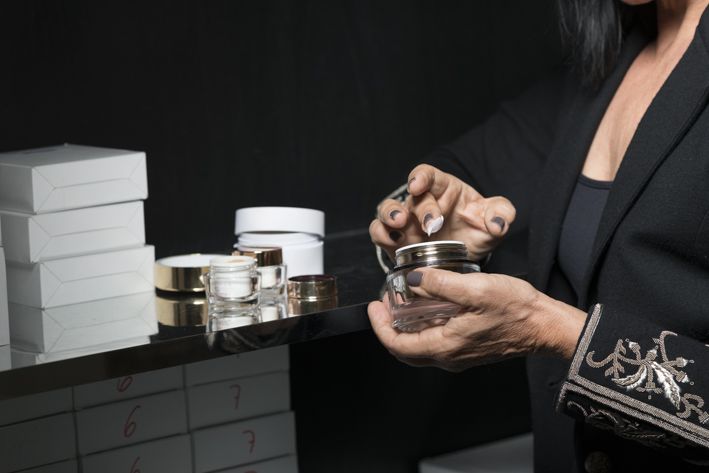Hyaluronic Acid: What Advantage does it Really have in Creams?

Whether day skin care, serum or gel, hyaluronic acid is lauded as THE miracle weapon in the field of anti-aging. It is purported to cushion the skin, smooth wrinkles and balance roughness. But is the praise really justified?
The body’s own natural substance
Hyaluronic acid (HA for short) is, at least, not foreign to the body. Chemically speaking, it is a polysaccharide, i.e. a multiple sugar, and thus an important component of various types of connective tissue. It is the main component of our synovial fluid and lubricates the joints. The largest proportion of HA, about 50 percent, is stored in the skin. Its task is to bind enormous amounts of water – up to six liters per gram. Unfortunately, the body’s own production also decreases with age, starting from around the age of 25. At 50, the water reservoirs are only half full and this begins to become noticeable in the outside appearance: Fine lines and wrinkles, sunken cheeks, crow’s feet or a deepening of the nasolabial fold are classic signs of hyaluronic acid deficiency. The elasticity of one’s own skin, the so-called skin turgor, can be measured easily: one raises a skin fold on the hand with two fingers and releases it. Depending on the moisture content, the wrinkle remains or restores itself elastically. By the way, cracking joints are also an indication that hyaluronic acid is decreasng in the synovial fluid.
Chain reaction
The empty depots cannot be filled as easily as one might imagine, and certainly not with an externally applied cream. Whether this has an effect and what that effect may be is mainly due to the size of the HA molecules. Simone Presto, physician and expert for the Eucerin HyaluronPlus series, confirms this: “The long-chain (high-molecular) hyaluronic acid is a very large molecule which remains on the skin. The medium-chain hyaluronic acid penetrates a little deeper into the superficial skin layers through the epidermis, up to about the middle of the 12 epidermal layers. The short-chain (low-molecular) hyaluronic acid can penetrate more deeply.” But, as the doctor admits, there is a limit here as well. Even the smallest HA molecules cannot break through the basal membrane, the bottom layer of the epidermis, where cells are constantly produced. No innovative cosmetic can overcome this. The short-chain hyaluronic acid is deposited there and swells up because it binds water from the tissue. In this way, it can not only ensure that wrinkles become flatter, but also that cell communication is maintained. Ultimately, it supports the physiological processes of the skin. The basic prerequisite, however, is that enough moisture is already present in the tissue. Simone Presto also stresses: “This is why it is so important to drink enough fluid. After all, it is up to me to provide the skin with moisture from below, which can then be bound above.”
Nerd knowledge
Strictly scientifically, Hyaluronic acid has been called Hyaluronan for several years. Until the end of the 90s it was extracted from cockscombs, today it is obtained from yeast or grain by fermentation, a vegan alternative which is much more tolerable. The molecular mass is measured in Dalton (kd stands for kilodalton and is named after the English natural scientist John Dalton, who studied atomic theory). High-molecular hyaluronic acid has 1,500 kD, medium-chain 100 kD and short-chain 50 kD or less. Incidentally, when ingredients are indicated on cosmetic products, the so-called INCI, all variants are called sodium hyaluronates. If you want more information about what your cream contains, you should contact the manufacturer. If the aim of a cosmetic product is to moisten more than just the surface, both long- and short-chain molecules must be present in high concentrations. Even if the industry would like to convince you of the contrary, no care product can lift facial contours, enlarge the lips or iron out deep wrinkles. Only hyaluronan injections given by your beauty practitioner can build up targeted volume on individual facial areas. These can penetrate to deeper skin layers and thus achieve more intensive and long-term effects.
Continuous operation
For hyaluronic acid to really have an effect, it must be used long-term. Simone Presto: “The skin’s own enzymes, the hyaluronidases, break down hyaluronic acid. In the case of a care product, this is usually within 12 hours. That’s why cream should be applied twice a day to maintain the effect.” If the skin barrier is weak, this will only help to a limited extent. Strengthening the barrier layer is necessary for long-term moisture penetration. The outermost layer of the epidermis, the so-called horny layer (stratum corneum), maintains the actual protection of the skin against the environment and prevents excessive moisture loss. Urea, vitamins and ceramides are among the most important active substances that strengthen the barrier function.
Foto: @up_n_co
Anti-Aging, hyaluronic acid, skin moisture, water reservoirs, water retention

CultureAndCream Author from Munich
To travel during my profession as a beauty journalist was never enough for my. Also my six month on a world trip didn’t do it. It always attracts me to other cities, foreign countries, on roadtrips and places I don’t know yet. But I am not only interested in “culture” and “cream”, I am also fascinated by people who have stories to tell . Such unique experiences I want to share with you.